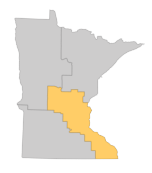
View of the Mississippi River from atop a steep bluff prairie.
The Central region includes twenty-three counties plus the Twin Cities metropolitan area and is home to more than half of all the state’s human population. Despite large swaths of urban development, the region supports more plant and animal biodiversity than any other region. This high biodiversity is a result of several factors: the region overlaps with of three of the state four ecological provinces: Tallgrass Aspen Parklands, Laurentian Mixed Forest, and Eastern Broadleaf Forest. The region also includes areas considered both glaciated and unglaciated. This results in a diverse landscape of northern forests, sand dunes and barrens, bluff prairies, limestone cliffs, and major river floodplains –all providing important habitat for wild species.

Regional highlights

Regional Plant Ecologist collecting data on a butternut tree found growing on a steep bluff prairie.
Butternut conservation
Butternut is a state-listed endangered tree species in the walnut family (Juglandaceae). It is becoming increasingly rare due to a deadly canker disease caused by a non-native fungal pathogen. Complicating its conservation, native butternut hybridizes with Japanese walnut. Hybrid trees are highly productive and have been breed and sold in the horticultural trade for many years. Planted hybrids have been recently shown to spread into natural landscapes. Regional Plant Ecologists are working to document these hybrid trees to provide further insight into the greater conservation needs for this species.



From left: Butternut shells; Close up of hybrid butternut buds in front of tree trunk; Butternut twig sliced open to see chambered pith.

Regional Plant Ecologist collecting data in the field.
Documenting rare plants and places
The Regional Plant Ecologists conduct plant surveys on public and private lands, often targeting rare species. These surveys help us better understand where these plants occur throughout the state as well as what native plant communities they occur in. The data collected is used to inform species and site-level conservation plans along with habitat management guidance that can be utilized by land managers.




From left: Tapertip flatsedge photographed next to a mechanical pencil for scale; Lance-leaved violet growing up through grassy material; State threatened hooded arrowhead in flower; The small flower of old-field toadflax being held between fingers for examination.

View of valley from bluff prairie.
Searching for historical plant species
Plants are considered historical if not observed in the last 20 years or more on the natural landscape. Sometimes these plants are truly gone, but in some cases, they may be considered historical merely because of lack of searching. Regional Plant Ecologists survey for these plants to help confirm if they are no longer present in the state. Confirming the presence or absence of historic species helps us to better target our conservation efforts. Herbaria, libraries of preserved plant specimens, are important in helping us understand where historic plants were once found.



From left: Pressed specimen of Erigeron pulchellus var. tolsteadii from the Bell Museum Herbarium; Pressed chinquapin oak specimen from the Bell Museum Herbarium; Pressed specimen of slim-pod Venus’ looking-glass from the Bell Museum Herbarium.

Amanda Weise
Regional Plant Ecologist

Linnea Lopez
Asst. Regional Plant Ecologist

